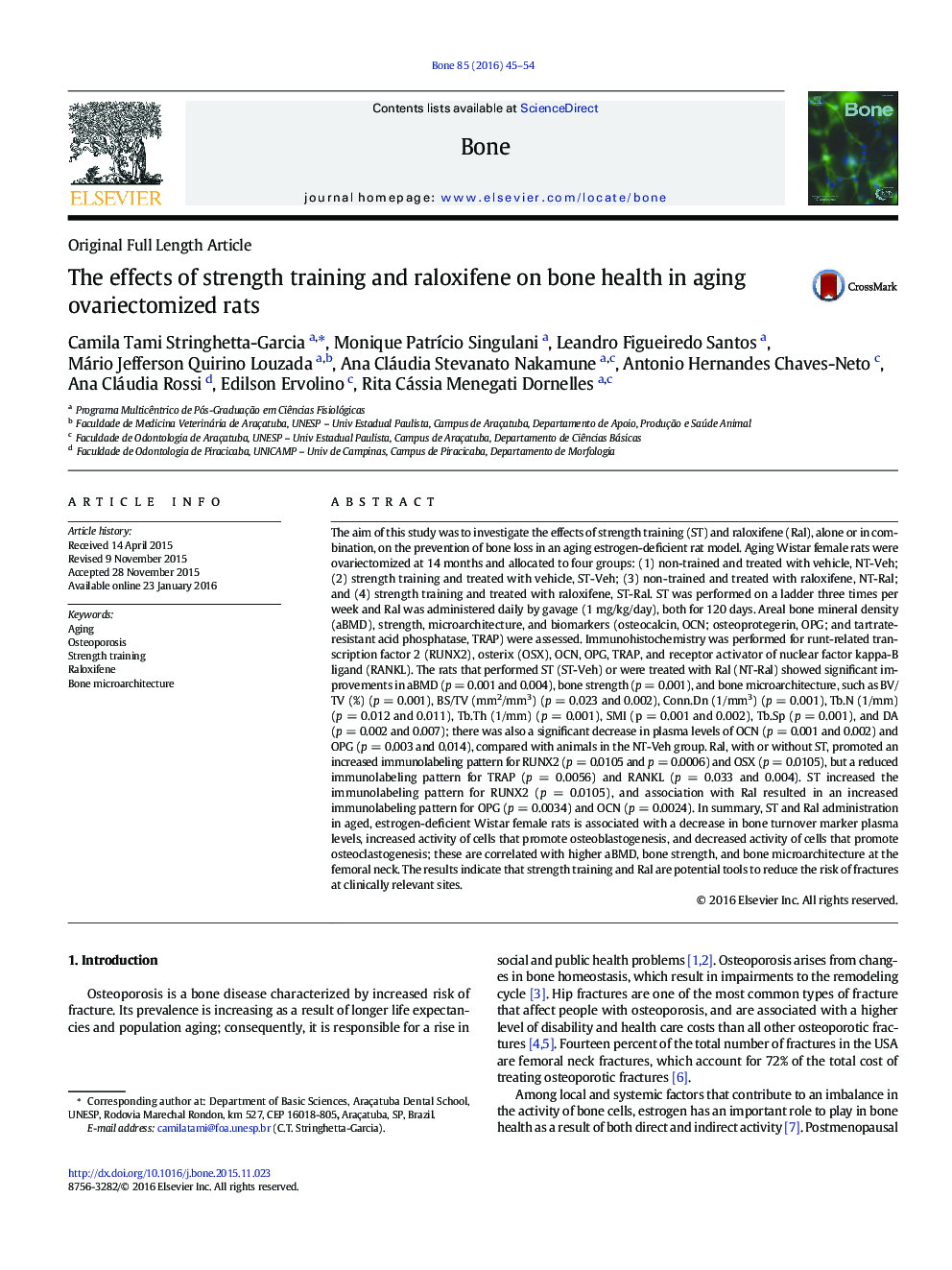| کد مقاله | کد نشریه | سال انتشار | مقاله انگلیسی | نسخه تمام متن |
|---|---|---|---|---|
| 2779127 | 1568134 | 2016 | 10 صفحه PDF | دانلود رایگان |
• Bone loss in the femoral neck is attenuated by strength training and raloxifene
• Strength training and raloxifene improved bone microarchitecture and strength in aging
• Strength training and raloxifene improved immunolabeling pattern for RUNX-2
• Strength training and raloxifene resulted in a reduction of the SMI and DA.
• Strength training is as effective as raloxifene in osteoporosis prevention.
The aim of this study was to investigate the effects of strength training (ST) and raloxifene (Ral), alone or in combination, on the prevention of bone loss in an aging estrogen-deficient rat model. Aging Wistar female rats were ovariectomized at 14 months and allocated to four groups: (1) non-trained and treated with vehicle, NT-Veh; (2) strength training and treated with vehicle, ST-Veh; (3) non-trained and treated with raloxifene, NT-Ral; and (4) strength training and treated with raloxifene, ST-Ral. ST was performed on a ladder three times per week and Ral was administered daily by gavage (1 mg/kg/day), both for 120 days. Areal bone mineral density (aBMD), strength, microarchitecture, and biomarkers (osteocalcin, OCN; osteoprotegerin, OPG; and tartrate-resistant acid phosphatase, TRAP) were assessed. Immunohistochemistry was performed for runt-related transcription factor 2 (RUNX2), osterix (OSX), OCN, OPG, TRAP, and receptor activator of nuclear factor kappa-B ligand (RANKL). The rats that performed ST (ST-Veh) or were treated with Ral (NT-Ral) showed significant improvements in aBMD (p = 0.001 and 0.004), bone strength (p = 0.001), and bone microarchitecture, such as BV/TV (%) (p = 0.001), BS/TV (mm2/mm3) (p = 0.023 and 0.002), Conn.Dn (1/mm3) (p = 0.001), Tb.N (1/mm) (p = 0.012 and 0.011), Tb.Th (1/mm) (p = 0.001), SMI (p = 0.001 and 0.002), Tb.Sp (p = 0.001), and DA (p = 0.002 and 0.007); there was also a significant decrease in plasma levels of OCN (p = 0.001 and 0.002) and OPG (p = 0.003 and 0.014), compared with animals in the NT-Veh group. Ral, with or without ST, promoted an increased immunolabeling pattern for RUNX2 (p = 0.0105 and p = 0.0006) and OSX (p = 0.0105), but a reduced immunolabeling pattern for TRAP (p = 0.0056) and RANKL (p = 0.033 and 0.004). ST increased the immunolabeling pattern for RUNX2 (p = 0.0105), and association with Ral resulted in an increased immunolabeling pattern for OPG (p = 0.0034) and OCN (p = 0.0024). In summary, ST and Ral administration in aged, estrogen-deficient Wistar female rats is associated with a decrease in bone turnover marker plasma levels, increased activity of cells that promote osteoblastogenesis, and decreased activity of cells that promote osteoclastogenesis; these are correlated with higher aBMD, bone strength, and bone microarchitecture at the femoral neck. The results indicate that strength training and Ral are potential tools to reduce the risk of fractures at clinically relevant sites.
Journal: Bone - Volume 85, April 2016, Pages 45–54
